Featured Application
The present work studies the difference when assessing the solar energy potential of Saudi Arabia by using the Liu–Jordan (isotropic) and Hay (anisotropic) models.
Abstract
The present work investigated the performance of an isotropic (Liu–Jordan, L–J) and an anisotropic (Hay) model in assessing the solar energy potential of Saudi Arabia. Three types of solar collectors were considered: with southward fixed-tilt (mode (i)), with fixed-tilt tracking the Sun (mode (ii)), and with varying-tilt tracking the Sun (mode (iii)). This was the first time such a study was conducted for Saudi Arabia. The average annual difference between anisotropic (Hay) and isotropic (L–J) estimates is least ≈38 kWhm−2 year−1 over Saudi Arabia for mode (i), and therefore, the L–J model can be used effectively. In modes (ii) and (iii), the difference is greater (≈197 and ≈226 kWhm−2 year−1, respectively). It is, then, up to the solar energy engineer to decide which model is to be used, but it is recommended that the Hay model be utilised for mode-(iii) solar collectors. These results fill a research gap about the suitability of models in practice. An interesting feature for the ratio of the annual mean solar energy yield of Hay over L–J as function of the latitude, φ, and the ground albedo, ρr, is the formation of a “well” for 29° ≤ φ ≤ 31° and 1.15 ≤ ρr ≤ 1.
1. Introduction
The knowledge of solar irradiation on tilted surfaces of any mode is significant for engineers who specialise in the design of flat-plate collectors, photovoltaic systems, or any other type of solar energy collecting devices. Solar radiation is recorded on a horizontal plane at fewer sites worldwide than meteorological parameters [1]. On the other hand, solar radiation measurements on inclined surfaces are indeed rare [2,3]. The development of solar radiation models for its estimation on horizontal surfaces was an initiative and need since the beginning of 1950s; nowadays, many such models exist in the international literature [4].
The exploitation of solar energy as a renewable energy source (RES) has triggered the need for the development of solar models that estimate solar energy received by devices with (static or moving) inclined surfaces, such as photovoltaic (PV) systems. A good account of the most usable transposition models (models that estimate solar energy on a tilted surface from its horizontal value) is given in [4]. In practice, these models provide expressions for the estimation of the diffuse solar energy on the tilted surface from its value on horizontal plane, since the direct and ground-reflected solar radiation components can easily be calculated; then, the global tilted solar radiation is the sum of the three components. Nevertheless, the accuracy of such models must be verified against solar radiation measurements.
There exist many studies that have tried to estimate and evaluate the accuracy of such transposition models worldwide; e.g., [5,6,7,8]. From these works, it seems that the error derived by the models varies from place-to-place, indicating the need for individual assessments of solar energy estimates by any transposition model used at the place of interest. The following studies are indicative of this conclusion. Kambezidis et al. [9] showed that the (isotropic) Liu–Jordan (L–J) [10], the (anisotropic) Gueymard [11], the Hay [12,13], the Reindl [14], and the Skartveit-Olseth [15] models perform best for Athens, Greece. Nijmeh and Mamlook [6] found that the L–J and Hay models perform equally well in Amman, Jordan; the isotropic model gives slightly better estimates in the summer, and the Hay one the rest of the year. Evseev and Kudish [5] evaluated 11 transposition models at Beer Sheva, Israel, and found that the best-performing ones were the Ma-Iqbal [16] and the Muneer [17] models. Lave and Kleissl [18] used the Page [19] model to find the optimum fixed orientations for capturing solar radiation in the continental USA. Yasin et al. [20] used the L–J model [10] to compute the daily optimum tilt angle as a function of the day-of-the-year and geographical latitude in the range [40° S, 40° N]. David et al. [8] compared the performances of the Gueymard, the Hay, the Perez [21], and the Skartveit-Olseth models to estimate the solar radiation on surfaces with different tilt angles and orientations at Saint Pierre, Reunion island. They found that the best-performing model is the Perez one, which is more complicated in the analytical expressions and the parameters used than the other three. Diez-Mediavilla et al. [22] compared 10 models to estimate the diffuse solar radiation on an inclined surface at Valladolid, Spain. The best-performing model was the Muneer one, followed by the Reindl model. Notton et al. [23] utilised 15 models (including the Gueymard, the Hay, the Perez, and the Skartveit-Olseth ones) to predict the solar irradiance on sloped surfaces with tilt angles of 45° and 60° towards the south; they compared them with solar radiation measurements at Ajaccio, France, and found that the best-performing model was the Perez model.
Apart from the use of solar radiation measurements or solar radiation modelling to assess the solar potential in a region, satellite observations and modern statistical methods have been applied to solar radiation or RES in general; e.g., [24,25,26].
From the above deployments, the initial hypothesis that no transposition model has an eminent performance seems true, with the exception of the Perez model, which rightly gives generally better performance than the others because of the many intrinsic parameters and complexity it uses. As far as Saudi Arabia is concerned, there has been no comparison of transposition models to the knowledge of the authors, probably due to the lack of systematic solar radiation measurements on either horizontal or inclined planes. Therefore, such a comparison was performed for the first time for Saudi Arabia in the present work, and this constitutes its novelty. Further, no practical guidelines about the suitability of an isotropic or an anisotropic solar model depending on the solar system configuration-mode exist for Saudi Arabia. This gap is bridged in the present study.
The Saudi Arabian National Centre for Science and Technology (SANCST, later renamed to KACST) initiated the Renewable Resource Atlas of the Kingdom of Saudi Arabia in the early 1980s, covering the period 1971–1980. In 1999, a new Solar Radiation Atlas for Saudi Arabia was generated as a cooperation between KACST and the US Deptartment of Energy [27]. A network of 12 solar radiation stations was set-up for this purpose. Later, in 2013, the King Abdullah City for Atomic and Renewable Energy (KACARE) initiated the Renewable Resource Monitoring and Mapping (RRMM) programme with international collaboration. One of the products of this project was a new Renewable Resource Atlas for Saudi Arabia, covering the period 1994–2012 [27].
The first Solar Radiation Atlas for the Arab World (SRAAW) was derived in 2004 [28]. The SRAAW included Morocco, Algeria, Tunisia, Egypt, and the Arabian Peninsula (Saudi Arabia, UAE, Kuwait, Syria, Jordan, Bahrain), and gave the distribution of the monthly and annual mean solar irradiation in the territory. Later in 2019, the World Bank [29] presented a solar atlas for Saudi Arabia exclusively, which includes the distribution of the three solar radiation components (global, diffuse, direct) on the horizontal plane over the country. Alwadei et al. [24], Farahat et al. [30,31] and Kambezidis et al. [32] applied the methodology developed by Kambezidis and Psiloglou [33] and presented for the first time solar atlases for Saudi Arabia for a solar receiving system (e.g., PV) with: (i) southward fixed-tilt (static system), (ii) fixed-tilt tracking the Sun (one- or single-axis system), and (iii) varying-tilt tracking the Sun (two- or dual-axis system). In these studies, the transposition model used was the isotropic L–J with a near-real ground-albedo value instead of the commonly used 0.2. The present work repeated the calculations of [30,31,32] by using an anisotropic transposition model. The model selected was the Hay one, because of its simplicity and its general accuracy, as shown earlier.
Despite the growing rate of PV system installation, these solar systems are not free from failures due to malfunctions in the moving parts (in the case of dynamic systems), the prevailing sky conditions (especially overcast conditions), and the temperature sensors on them [34]. Further, a problem with PV parks is associated with the management of the distribution of the energy produced by the so-formed smart grid [35].
The structure of the paper is as follows. Section 2 describes the data collection and data analysis. The analysis includes calculations of the solar energy received by inclined flat-plate surfaces across Saudi Arabia with the three above-mentioned configuration modes and both transposition models (L–J, Hay). Section 3 presents the results of the study: annual, seasonal, and monthly solar energy sums are presented for both transposition models and are compared. Section 4 presents the conclusions and main achievements of the study. Acknowledgements and references follow.
2. Materials and Methods
2.1. Data Collection
The database for this work was the one used in three recent studies [30,31,32]. In brief, hourly values of Hb,0 (direct horizontal solar irradiance in Wm−2) and Hd,0 (diffuse horizontal solar irradiance in Wm−2) were downloaded from the PV—Geographical Information System (PV-GIS) tool [36] using the latest Surface Solar Radiation Data Set—Heliostat (SARAH) 2005–2016 data base (12 years) [37,38]. We selected 82 sites across Saudi Arabia in an arbitrary way in order to fully cover the whole country. Figure 1 shows the locations of the sites on the map of Saudi Arabia.
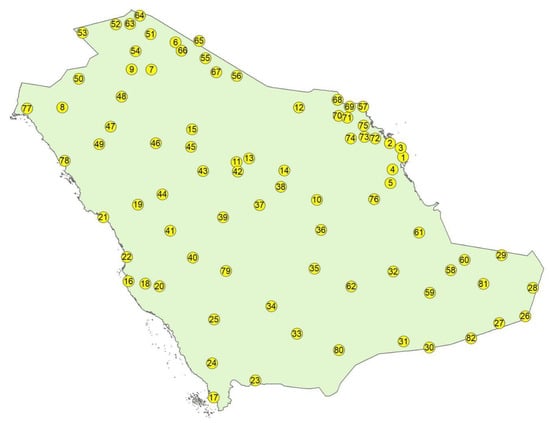
Figure 1.
Distribution of the 82 sites in Saudi Arabia. The numbers in the circles refer to those in column 1 of Table 1 reported in [30]. This figure is a reproduction of Figure 1 in [30].
2.2. Data Processing and Analysis
The processing of the Hb,0 and Hd,0 hourly values (in Wm−2) obtained from the PV-GIS platform was the same as that described in a previous work concerning the solar energy potential of Saudi Arabia [32], i.e., steps 1–5; therefore, that procedure is not reported here. The hourly global horizontal solar irradiance values, Hg,0 (in Wm−2), were calculated as the sums of the Hb,0 and Hd,0 ones.
Estimates of the inclined global solar irradiance on a flat-plate surface with (i) optimally selected, southward fixed-tilt angle, Hg,βS, (ii) optimally selected fixed-tilt angle tracking the Sun, Hg,βt, and (iii) varying-tilt angle tracking the Sun, Hg,t (all in Wm−2) were performed in the respective works of [30,31,32], by using the isotropic transposition L–J model [10]. The calculations in those studies used near-real ground-albedo values, ρg, retrieved from the Giovanni platform [39], instead of utilising the reference value of ρg0 = 0.2. This method was followed in the present study too.
The estimation of the global solar irradiance on an inclined surface in any of the above-mentioned types of solar systems is:
where the subscript x denotes βS, βt, or t according to the configuration of the solar system as (i), (ii), or (iii), respectively. The individual parameters on the right-hand side of Equation (1) are estimated through the following expressions [40]:
Hg,x = Hb,x + Hd,x + Hr,x,
Hd,x = Hd,0·Rd,MODEL
Hr,x = Hg,0·Rr·ρg,
Rb = max(cosθ/sinγ,0),
Rd,ISO = (1 + cosβ)/2
Rr = (1 − cosβ)/2
cosθ = sinβ·cosγ·cos(ψ − ψ′) + cosβ·sinγ.
Kb = min(Hb,0/Hex,1)
Hex = H0·S·sinγ
S = 1 + 0.033·cos(2·π·N/365).
In the above expressions:
- θ is the incidence angle (the angle formed by the normal to the inclined surface and the line joining the surface with the centre of the Sun, in degrees);
- β is the inclination of the tilted surface with respect to the local horizon (in degrees);
- ψ and ψ′ are the solar azimuths of the Sun and of the inclined plane, respectively (in degrees);
- γ is the solar elevation (or solar altitude, in degrees);
- in the case of (a) a southward fixed-tilt-angle surface (configuration-(i) system), β = constant, ψ = constant ≠ ψ′, θ ≠ 0°; (b) a fixed-tilt-angle surface tracking the Sun (configuration-(ii) system), β = constant, ψ = ψ′, θ ≠ 0°; and (c) a varying-tilt-angle surface tracking the Sun (configuration-(iii) system), β = 90° − γ, ψ = ψ′, θ = 0°;
- the subscripts ISO and HAY denote the isotropic L–J and anisotropic Hay models, respectively, and will be used as such in the rest of the work;
- the subscript MODEL denotes either ISO or HAY;
- H0 is the solar constant of 1361.1 W m−2 [41];
- S is the Sun–Earth distance correction factor [42];
- N is the day-of-the-year (N = 1 for 1 January, N = 365 or 366 for 31 December in a non-leap or leap year, respectively).
Hourly Hg,x values at the 82 sites in Saudi Arabia were derived for the 3 configuration types of solar systems by using the ISO model in the previous works [30,31,32]. These calculations were repeated in the present work by using the HAY model this time.
No comparison for the ISO- and HAY-modelled results with real solar radiation measurements could be made because such systematic measurements do not exist for the selected sites of Saudi Arabia. To overcome this shortcoming, a statistical comparison was decided to be performed relative to each other model’s results by taking the ISO case as reference.
3. Results
The main aim of this section is to present the solar energy sums across Saudi Arabia derived by both ISO and HAY transposition models, in which near-real ground-albedo values have been considered. These calculations were performed for the three configuration modes mentioned in the Introduction. Then, the results are compared in order to conclude on which transposition model is suitable for each solar system configuration mode in Saudi Arabia.
The solar energy sums are presented annually, seasonally, and monthly in order to show any resemblances or differences in the three configuration modes. Moreover, an independent statistical analysis of the annual solar energy sums is provided.
3.1. Annual Solar Energy
Annual solar energy sums were derived from the appropriate data base of each site by utilising MODEL = HAY in Equation (3). The annual solar energy sum (or yield) at each location was estimated by aggregating (summing up) all hourly solar radiation values within the period 2005–2016. These aggregations were done for the three configuration modes of solar systems mentioned in Section 2. Similar annual solar energy sums were derived in previous works [30,31,32] at the 82 sites by utilising MODEL = ISO. It should be noted here that for the system types (i) and (ii), certain optimal tilt angles were found in those works, and the country was divided into three solar energy zones (SEZ), which are depicted in Figure 2. The same optimum tilt angles were adopted here for the HAY model.
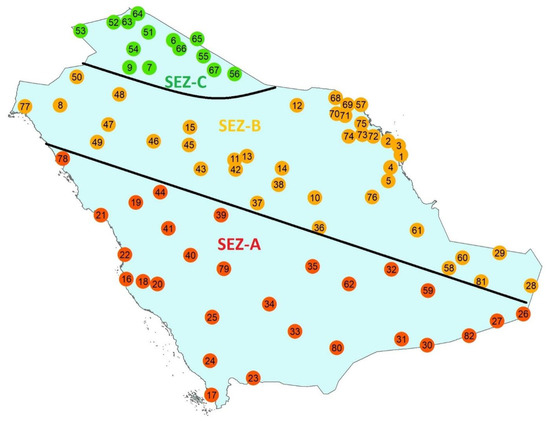
Figure 2.
Distribution of the 82 sites in Saudi Arabia into the 3 identified SEZs. For configuration-type-(i) solar systems, the optimum tilt angle is: β = 20° S (SEZ-A), β = 25° S (SEZ-B), β = 30° S (SEZ-C). For configuration-type-(ii) solar systems, the optimum tilt angle is: β = 40° (SEZ-A), β = 45° (SEZ-B), β = 50° (SEZ-C). For configuration-type-(iii) solar systems, the tilt angle is always varying, and therefore, this mode is independent from the location of the site. The numbers in the circles coincide with those in Figure 1. This figure is a reproduction of Figure 4 in [30].
Figure 3 shows the variation in the annual solar energy sums across the 82 sites; these sums were calculated by using both the ISO and the HAY models (see Equation (3)) applied to the three configuration modes of solar systems (see Equations (1)–(4)). It must be said here that all ISO and HAY calculations were performed by taking into account an annually averaged near-real ground-albedo value, ρg, specific for each site applied to Equation (4). The annual mean solar irradiation values found are: for a configuration-type-(i) solar system, 2414.16 kWhm−2 year−1 (ISO) and 2452.36 kWhm−2 year−1 (HAY); for a configuration-type-(ii) solar system, 2973.59 kWhm−2 year−1 (ISO) and 3170.38 kWhm−2 year−1 (HAY); and for a configuration-type-(iii) solar system, 3093.25 kWhm−2 year−1 (ISO) and 3319.00 kWhm−2 year−1 (HAY). From these figures, one can draw the following conclusions:
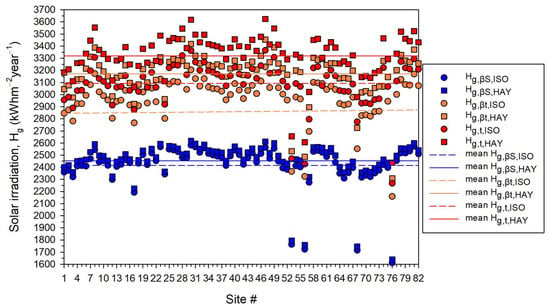
Figure 3.
Variation in the annual solar energy yields across the 82 sites of Saudi Arabia and averaged over the period 2005–2016 under all-sky conditions. The modelled variation is shown for the 3 solar system configuration modes and both ISO- and HAY-modelled results. The horizontal lines are the averages of the yields over all sites: the short-dashed ones indicate the ISO model and the solid lines the HAY model.
- The configuration-(i) solar systems produce almost identical annual solar energy yields in both ISO and HAY cases (see blue symbols in Figure 3).
- The annual mean solar energy yield increases from configuration (i) to configuration (iii) under the same calculation model (ISO or HAY).
- The annual mean solar energy yields in each solar system configuration are greater under the HAY model than those under the ISO.
- The annual mean solar energy yield generally increases from configuration-(i) ISO to configuration-(iii) HAY.
- There is only one exception that regards the annual mean solar energy yield of the configuration-(ii) HAY being greater than that of the configuration-(iii) ISO, i.e., 3170.38 kWhm−2 year−1 (ii-HAY) and 3093.25 kWhm−2 year−1 (iii-ISO); the explanation is not obvious but it can be attributed to the effect of the variation in the ground albedo across Saudi Arabia on the solar radiation estimation on the inclined surface of mode-(ii) HAY and mode-(iii) ISO; this discrepancy is depicted in Figure 4 and is investigated further in Section 3.3.
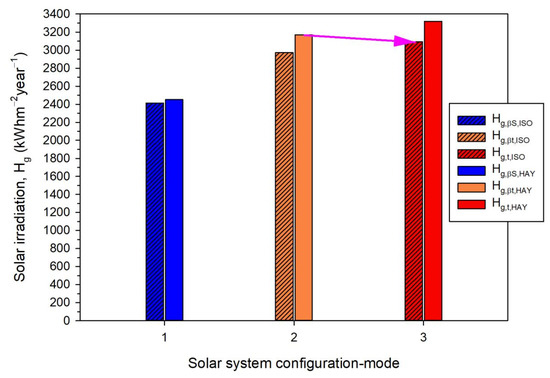 Figure 4. Annual solar energy yields averaged over the 82 sites in Saudi Arabia and the period 2005–2016 under all-sky conditions. The variations are shown for the 3 solar system configuration-modes and both ISO- and HAY-modelled results. The numbers 1, 2, and 3 on the x-axis represent the configuration modes-(i), -(ii), and -(iii), respectively. The pink arrow shows the lower solar energy in the configuration-(iii) ISO case compared to the configuration-(ii) HAY case.
Figure 4. Annual solar energy yields averaged over the 82 sites in Saudi Arabia and the period 2005–2016 under all-sky conditions. The variations are shown for the 3 solar system configuration-modes and both ISO- and HAY-modelled results. The numbers 1, 2, and 3 on the x-axis represent the configuration modes-(i), -(ii), and -(iii), respectively. The pink arrow shows the lower solar energy in the configuration-(iii) ISO case compared to the configuration-(ii) HAY case. - The differences in the annual mean solar energy sums, Hg,HAY − Hg,ISO, are as little as 38.20 kWhm−2 year−1 for configuration mode (i), 196.79 kWhm−2 year−1 for configuration mode (ii), and 225.75 kWhm−2 year−1 for the configuration mode (iii); this outcome may justify the option of using the L–J transposition model to estimate solar radiation on inclined surfaces, especially those which face south.
- The above conclusion is indeed true because the value of (1) 38.20 kWhm−2 year−1 corresponds to just ≈1.6% of either the annual Hg,βS,ISO value or the annual Hg,βS,HAY one for configuration (i), i.e., (38.20/2414.16) × 100% or (38.20/2452.36) × 100%, respectively; (2) 196.79 kWhm−2 year−1 is equivalent to 6.6% or 6.2% of the annual Hg,βt,ISO value or the annual Hg,βt,HAY one for configuration (iii), i.e., (196.79/2973.59) × 100% or (196.79/3170.38) × 100%, respectively; and (3) 225.75 kWhm−2 year−1 is translated to 7.3% or 6.8% of the annual Hg,t,ISO value or the annual Hg,t,HAY one for configuration (ii), i.e., (225.75/3093.25) × 100% or (225.75/3319.00) × 100%, respectively.
- The ratios Hg,HAY/Hg,ISO are: 1.016 (mode (i)), 1.066 (mode (ii)), and 1.073 (mode (iii)).
- The differences and the ratios increase from mode (i) to mode (iii).
Figure 5 shows the ratio of the annual mean solar energy yields for all sites according to the HAY-modelled estimates to those of the ISO-modelled estimates as a function of the geographical latitude, φ (in degrees N). All three configuration modes have been considered, i.e., configuration mode (i) of βS, configuration mode (ii) of βt, and configuration mode (iii) of t. The ratios are linear expressions of φ. The increasing trend of the linear expressions with φ implies a faster increase in the Hg,HAY values with φ than the Hg,ISO ones. Figure 6 gives explicit answers to these observations. It is seen that the best-fit linear curves to the individual cases of Hg have all negative trends with increasing φ, as expected, due to lower solar radiation levels with increasing latitude; nevertheless, the linear expressions for the same configuration mode (see legend of Figure 6) show quicker decreases in the Hg,HAY values with φ than the Hg,ISO ones, except for configuration mode-(i).
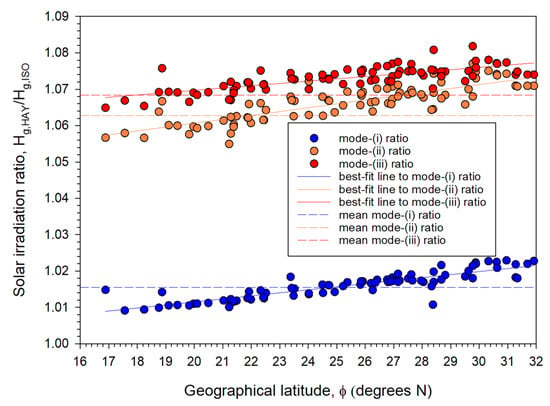
Figure 5.
Annual solar energy yield ratios, Hg,HAY/Hg,ISO, for the 82 sites in Saudi Arabia averaged over the period 2005–2016 as function of the geographical latitude of the site, φ, under all-sky conditions. The data are shown for the 3 solar system configuration modes and both ISO- and HAY-modelled results. The best-fit lines have the following expressions: configuration mode-(i), Hg,βS,HAY/Hg,βS,ISO = 0.9948 + 0.0008 φ with R2 = 0.78; configuration mode-(ii), Hg,βt,HAY/Hg,βt,ISO = 1.0394 + 0.0011 φ with R2 = 0.70; and configuration mode-(iii), Hg,t,HAY/Hg,t,ISO = 1.0571 + 0.0006 φ with R2 = 0.56.
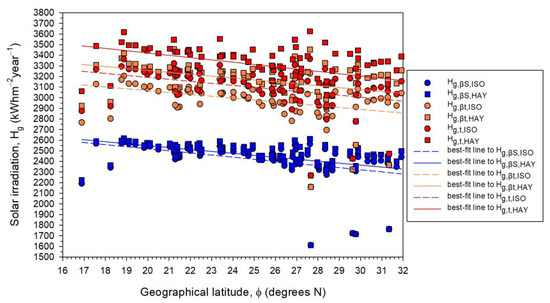
Figure 6.
Annual solar energy yields, Hg, at the 82 sites in Saudi Arabia averaged over the period 2005–2016 as a function of the geographical latitude of the site, φ, under all-sky conditions. The data are shown for the 3 solar system configuration modes and both ISO- and HAY-modelled results. The best-fit lines have the following expressions: configuration mode-(i), Hg,βS,ISO = 2914.9263 − 19.8053 φ with R2 = 0.18, Hg,βS,HAY = 2916.8787 − 18.3831 φ with R2 = 0.14; configuration mode-(ii), Hg,βt,ISO = 3418.2774 − 17.5874 φ with R2 = 0.14, Hg,βt,HAY = 3617.0141 − 17.9937 φ with R2 = 0.10; configuration mode-(iii), Hg,t,ISO = 3563.8445 − 18.6120 φ with R2 = 0.15, Hg,t,HAY = 3854.0829 − 21.6483 φ with R2 = 0.13.
3.2. Statistical Analysis of the Annual Solar Energy Values
The mean and standard-deviation values of the annual solar energy sums for all 82 sites and the three configuration modes are shown in Table 1. Attention must be paid to the standard-deviation values, which show that the dispersion of the solar energy sums across Saudi Arabia is rather uniform for the mode-(i) systems (181.08 kWhm−2 year−1 and 181.47 kWhm−2 year−1 for the ISO and HAY cases, respectively), but higher for the HAY-estimated values in the configuration mode-(ii) and -(iii) solar systems (compare 182.68 to 191.2 kWhm−2 year−1 and 186.88 to 198.49 kWhm−2 year−1). Configuration modes (ii) and (iii) indicate that the ground-albedo value has a higher effect on the estimation of solar radiation on the inclined surface. Moreover, the comparable standard deviations for the ISO solar energy values estimated under all configuration modes (compare 181.08, 182.68, and 186.88 kWhm−2 year−1) justify the insignificant effect of the ground-albedo value on isotropic modelling simulations.

Table 1.
Averages (AVG) and standard deviations (SD) of the ISO- and HAY-estimated annual solar energy sums across Saudi Arabia in the period 2005–2016 under all-sky conditions.
The correlation coefficients of the estimated annual solar energy sums across all 82 sites between the ISO- and HAY-modelled results are 0.999, 0.997, and 0.999 for the configuration modes (i), (ii), and (iii), respectively. These are considered high, as they show the absolute co-variability of the annual solar energy sums from the ISO and HAY models over all Saudi Arabia.
Despite the co-variability in the data series discussed above, a 2-sided t-test was applied to the annual mean values from the ISO model and those from the HAY model in the same configuration mode. This was done in order to find whether the data series of the individual average values are significantly different or not for the ISO- and HAY-derived solar radiation estimations in the same configuration mode. In all cases, the ISO data series were taken as the reference. The null hypothesis was that the average value of the HAY data series is equal to the mean value of the ISO data series, and the alternative hypothesis was that the mean values are different. The results of the t-tests are shown in Table 2. It is seen that the data series of the pair (Hg,βS,ISO, Hg,βS,HAY) shows no statistically significant differences between their mean values at the confidence level of 95% (t-test > tcr), whereas the opposite exists for the pairs (Hg,βt,ISO, Hg,βt,HAY) and (Hg,t,ISO, Hg,t,HAY) (t-test < tcr). In other words, the mean values of the Hg,βS,HAY time series are equal or very close to the mean values of the Hg,βS,ISO data series. The opposite (greater) is the case for the mean values of the Hg,βt,HAY and the Hg,t,HAY time series in comparison to those of the Hg,βt,ISO and the Hg,t,ISO time series. These results justify the average values shown in Table 1.

Table 2.
T-test per pair of the ISO- and the HAY-derived solar radiation values for Saudi Arabia in the period 2005–2016 for the 3 solar system configuration modes under all-sky conditions. df = degrees of freedom, tcr = critical value for the t-test. The confidence interval is 95% (α = 0.05).
The next test, as far as the significance of the differences among the ISO and the HAY data series for the three configuration modes is concerned, was performed by invoking the one-way ANOVA statistical process for testing the variances among the three (configuration-mode) data series in the ISO or the HAY case. The results of this process are shown in Table 3 considering a significance level of α = 0.05. Normal distribution for each data series was not required, because the population size was N > 20. The Levene test confirmed the null hypothesis (equality of variances), because p > α = 0.05 in both cases. In the ANOVA test, the null hypothesis was for the equality of the means of the data series, and the alternative hypothesis was their inequality. It is shown that there are significant differences among the three groups of the ISO and the HAY data series (p < α = 0.05), which confirms the inequality of the means (alternative hypothesis) and agrees with the results of Table 1. The same conclusions can be drawn from the post hoc test, because p < α = 0.05 and the upper and lower bounds of the 95% confidence interval (not shown) do not include the value of p = 0.

Table 3.
One-way ANOVA applied to the Hg,ISO or the Hg,HAY data series for Saudi Arabia in the period 2005–2016 under the 3 solar system configuration modes in all-sky conditions. df = degrees of freedom, p = probability. The confidence interval is 95% (α = 0.05).
In order to show the effect of using the ISO or the HAY diffuse model on the estimation of the Hg values, the Fisher–Snedecor test was invoked. To do that, three columns were formed: column 1 with categorisation into ISO and HAY; column 2 with classification of the configuration modes as 1 (i), 2 (ii), and 3 (iii); and column 3 with the Hg values in the sequence Hg,βS, Hg,βt, Hg,t. The F-test examined the influence of column 1 on the other two parameters. The null hypothesis in this case was that this influence is significant, while the alternative hypothesis dictated the opposite. Table 4 shows the F-test value of 659.287 being » F-testcr = 3.014. This supports the null hypothesis; i.e., the application of the diffuse model had a significant effect on the Hg values no matter what solar system configuration mode was used.

Table 4.
Fisher–Snedecor (F-test) statistic applied to the Hg,ISO and the Hg,HAY data series for Saudi Arabia in the period 2005–2016 under the 3 solar system configuration modes in all-sky conditions. df = degrees of freedom, p = probability, N = population size of each individual data series. The confidence interval is 95% (α = 0.05).
3.3. Seasonal Solar Energy
This section provides a comparison of the estimated seasonal solar energy yields as calculated by the ISO and the HAY models. Figure 7 is a bar chart which shows the seasonal Hg values for the three configuration modes and both modelled estimates. From the diagram, the following are clear:
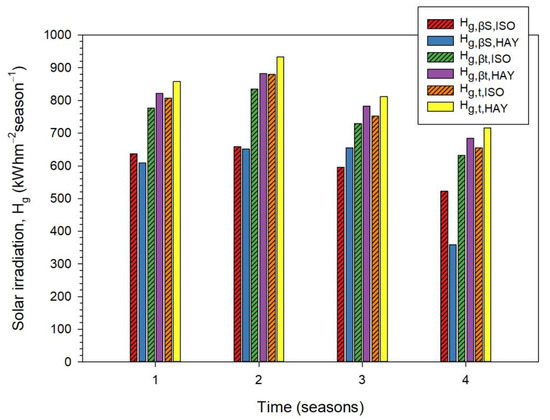
Figure 7.
Seasonal solar energy yields, Hg, averaged across the 82 sites in Saudi Arabia and the period 2005–2016 under all-sky conditions. The values are shown for the 3 solar system configuration modes and both ISO- and HAY-modelled results. The shaded bars indicate the ISO estimates, and the solid bars the HAY ones. The seasons on the x-axis are spring (1) to winter (4).
- In the seasons of spring, summer and especially winter, the solar irradiation in the mode-(i) ISO case is greater than in the mode-(i) HAY case; a similar conclusion has been drawn in [43].
- In all seasons, the mode-(ii) HAY solar irradiation is a little greater than the mode-(iii) ISO solar irradiation; this explains the outcome in Figure 4 (see the pink arrow).
- The summer solar irradiation values are greater, as expected, than those in the other seasons of the year.
3.4. Monthly Solar Energy
The presentation of the annual and the seasonal solar irradiation comparisons between the ISO- and the HAY-modelled results takes place in this section. Figure 8 shows the intra-annual variation of Hg for the three configuration modes and both transposition models. In the case of a solar system with configuration type-(i), the monthly values of Hg,βS,ISO and Hg,βS,HAY are almost identical (see the blue symbols and the lines in Figure 8). This means that the L–J model provides satisfactory results for a flat-plate solar collector with a fixed-tilt angle and southward orientation. This isotropic model has been used by many authors in studies for estimating solar insolation on mode-(i) solar collectors, e.g., in [44].
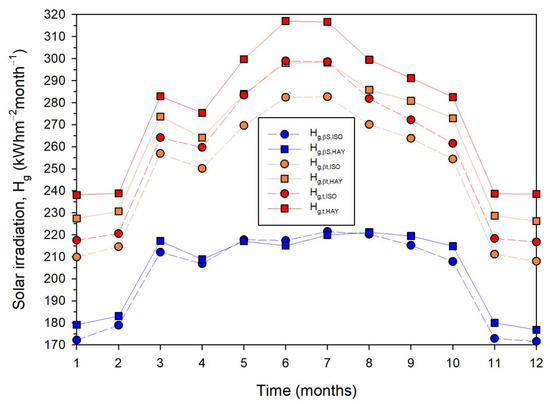
Figure 8.
Intra-annual variation of the solar energy yields, Hg, averaged across the 82 sites in Saudi Arabia and the period 2005–2016 under all-sky conditions. The values are shown for the 3 solar system configuration modes and both ISO- and HAY-modelled results. The months on the x-axis are from January (1) to December (12).
For the other two modes, the order of higher to lower monthly solar irradiation values is Hg,t,HAY, Hg,βt,HAY, Hg,t,ISO, Hg,βt,ISO. Nevertheless, the difference between the HAY- and the ISO-estimated solar radiation in the same configuration type lies in the range [100, 200] kWhm−2 month−1. This means that if any of the two transposition models is used by the interested solar energy engineer, the result may not be acceptable as the difference is in the range [3.33, 6.66] kWhm−2 day−1. Indeed, these differences are not negligible compared to the daily solar energy gained by a flat-plate solar collector working in Saudi Arabia in mode (ii) with a fixed-tilt angle tracking the Sun or in mode (iii) with a varying-tilt angle tracking the Sun, i.e., a daily average of ≈8.5 kWhm−2 day−1 throughout the year. In this case, the error introduced when considering the difference Hg,HAY − Hg,ISO, is in the range [39.2%, 78.4%], which is deemed quite high. Therefore, the solar energy engineer must be cautious about what model to choose for assessing the solar energy potential at a location. On the other hand, it is common practice for solar energy engineers to use an anisotropic model for assessing the solar energy potential on inclined solar collectors; see [45]. This is true for configuration type-(ii) and -(iii) solar collectors, and for mode-(i) solar systems, the L–J model can safely be used.
3.5. Dependence of Solar Energy on Latitude and Ground Albedo
Up to this point, no mention has been made of the influence of the ground albedo on the solar energy received by the inclined surfaces in the three types of solar system configurations. This factor may be important, as it contributes a ground-reflected radiation component to the inclined surface of the collector. The intensity of this component becomes greater for higher values of the ground albedo and greater tilt angles of the inclined surface, as can be justified by Equation (4). It is easily concluded from this equation that for the system configuration modes-(i) and -(ii), the ground-reflected radiation depends only on the ground-albedo value, as the tilt angle is constant. Nevertheless, this is not the case for the configuration type-(iii) systems, as the tilt angle is always varying throughout the day. To show this dependence, 3D graphs of the annual mean ratios, Hg,HAY/Hg,ISO, were prepared as functions of the geographical latitude, φ, and the ground–albedo ratio, ρr = ρg/ρg0 = ρg/0.2 of the site for the three configuration modes. We avoided including the tilt angle, β, as an independent variable in the graph, especially for configuration mode-(iii), as β does not vary within standard limits at the 82 sites as φ or ρr does. Figure 9 depicts the above-mentioned dependence of the solar irradiation ratio on φ and ρr. The main characteristic in all three figures is the abruptly low ratio values (in the form of “wells”) in the ranges 28.5° ≤ φ ≤ 31.0° and 1.15 ≤ ρr ≤ 1.55. The sites that belong to this area of Saudi Arabia lie in two groups: group A, 6, 7, 9, 54, 55, 56, 65, 67, and 68; and group B, 50 and 68. All nine sites of group A belong to SEZ-C, and the two sites of group B lie in SEZ-B. Due to this outcome, sites 50 and 68 should move to SEZ-C (i.e., to the group A of sites); this would result in shifting the SEZ-B/SEZ-C interface downward in order to include the two sites (i.e., a downward shift of the upper black line in Figure 2). Nevertheless, the values of the Hg,HAY/Hg,ISO ratios in the wells for the two sites, 50 and 68, were found to be greater (not indicated here) than those at the sites of group A. This fact made us consider that there is no actual need to perform this shift.
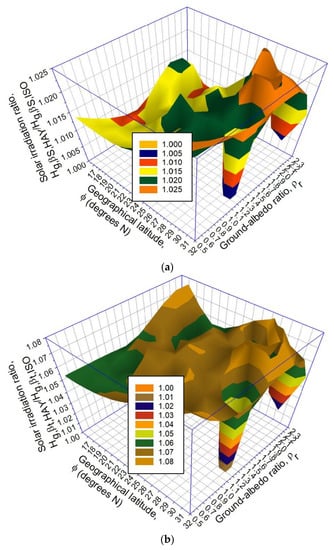
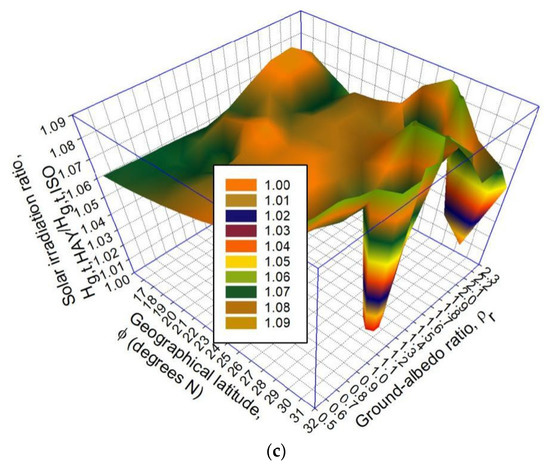
Figure 9.
3D plots of the ratio Hg,HAY/Hg,ISO as functions of the geographical latitude, φ, and the ground–albedo ratio, ρr, for Saudi Arabia under all-sky conditions. The solar irradiation ratios are averages of the annual mean solar irradiations, Hg,HAY and Hg,ISO, at each of the 82 sites and the period 2005–2016. The solar irradiation ratios cover system configuration (a) mode (i), (b) mode (ii), and (c) mode (iii). The (x,y,z) triads in the graphs refer to the parameters (φ, ρr, Hg,HAY/Hg,ISO), respectively.
The best-fitted surfaces to the data in Figure 9 (82 x,y,z triads) have been determined by graphics software (SigmaPlot 14.0) in around 9 s of computational time.
3.6. Solar Energy Potential of Saudi Arabia
Previous studies [30,31,32] have derived the solar energy potential of Saudi Arabia for all three types of solar collectors by using the L–J model. In this section, the distribution of the annual mean solar irradiation over the country is given for the three configuration modes but by using the HAY model. Figure 10 gives, side-by-side, the solar energy potential for the same configuration mode under the ISO and the HAY models for comparison. The following observations can, therefore, be drawn:
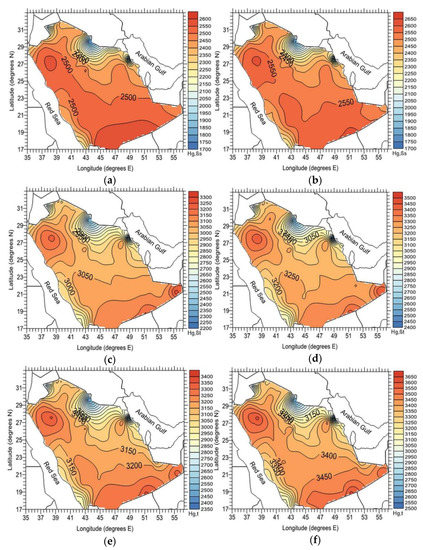
Figure 10.
Distribution of the annual solar irradiation sums, Hg, averaged over Saudi Arabia in the period 2005–2016 under all-sky conditions. The left maps (a,c,e) were derived by using the ISO model, and the right maps (b,d,f) with the HAY one. The solar energy potential is shown in the system configuration: mode (i) in (a,b), mode (ii) in (c,d), and mode (iii) in (e,f). Figure 10a is a reproduction of Figure 7b in [30], Figure 10c is a corrected version of Figure 8b in [31], and Figure 10e is a corrected version of the map in Figure 8b of [32]. The colour code represents the Hg levels (in kWhm−2 year−1).
- The pattern of the Hg isolines is almost the same in any mode or model used.
- Any differences in solar energy isoline patterns presented in Figure 10a–f may be due to the anisotropic ground-albedo pattern around the 82 sites [46] that has a varying influence on the estimation of the Hg values in the various operation modes and models used.
- Figure 10c,e shows re-drawn maps of solar energy in Saudi Arabia for flat-plate solar collectors with mode-(ii) and (iii) ISO operations; the original maps in Figure 8b and Figure 9 presented in [32,33], respectively, showed an extended Hg minimum with a centre at λ = 49° and φ = 27°, which was an invalid result.
4. Conclusions and Discussion
The main aim of the present study was comparing the global solar radiation on inclined surfaces in three configuration modes by using an isotropic and an anisotropic model for the assessment of the diffuse solar radiation on such surfaces. The solar collector types considered were: (i) southward fixed-tilt surface, (ii) fixed-tilt surface tracking the Sun, and (iii) varying-tilt surface tracking the Sun. These types were denoted as mode (i), mode (ii), and mode (iii), respectively. The estimates for all three modes and both isotropic and anisotropic models were compared against each other because of lack of systematic global horizontal or global inclined radiation measurements throughout Saudi Arabia. The isotropic model selected was the Liu–Jordan one (ISO), and the anisotropic model was the Hay (HAY).
The analysis showed that for mode (i), the average annual difference of Hg,βS,HAY − Hg,βS,ISO estimates was at least (≈38 kWhm−2 year−1) over Saudi Arabia. This difference is much smaller than any monthly mean value of Hg (cf. Figure 8). Therefore, the ISO model can be used effectively for mode-(i) estimates. For solar systems in mode-(ii) operation, the difference of ≈197 kWhm−2 year−1 is comparable to a mode-(i) autumn/winter mean monthly Hg value, but definitely less than any monthly value for mode-(ii) systems (cf. Figure 8). This outcome dictates the choice of using the ISO model with a relatively larger estimation error or the HAY model with relatively higher accuracy. For mode-(iii) solar systems, the difference of ≈225 kWhm−2 year−1 is much higher than any mode-(i) monthly mean Hg value, but comparable to any autumn/winter monthly mean Hg value (cf. Figure 8). Therefore, it is recommended that the HAY model must be preferred to the ISO one in this case.
The annual mean Hg,t,HAY (3093.25 kWhm−2 year−1) was found to be less than the Hg,βt,ISO (3170.38 kWhm−2 year−1). This discrepancy was attributed to the effect of the ground-albedo variation across Saudi Arabia on the solar radiation estimations for the inclined surfaces in mode-(ii) HAY and mode-(iii) ISO.
The ratio Hg,HAY/Hg,ISO for the annual mean solar energy yields for all sites and all three modes is a linear function of the geographical latitude, φ. The increasing trends of the linear expressions implies a quicker increase in the Hg,HAY values with φ than with the Hg,ISO ones.
As stated in Section 2, comparison of the derived results with real measurements could not be feasible because of a lack of systematic solar radiation measurements throughout Saudi Arabia. To overcome this difficulty, comparison of the results between the ISO and the HAY cases was considered by taking the ISO time series as a reference. Specific statistical metrics were employed with the following conclusions:
- The annual average Hg values estimated for all Saudi Arabia increase from mode-(i) to mode-(iii) solar system operations; a discrepancy, though, exists for the annual Hg,iii-ISO value, it being less than the Hg,ii-HAY one.
- The annual standard deviation of Hg values for all Saudi Arabia increase from mode-(i) to mode-(iii) solar system operations; nevertheless, these values are almost equal for the configuration mode-(i) ISO and HAY cases.
- Application of the t-test to the annual mean values for the (Hg,ISO, Hg,HAY) data-series pairs showed that the data series of the (Hg,βS,ISO, Hg,βS,HAY) pair had no statistically significantly different mean values at the confidence level of 95%, whereas the opposite existed for the pairs (Hg,βt,ISO, Hg,βt,HAY) and (Hg,t,ISO, Hg,t,HAY).
- The Levene test confirmed the equality-of-the-annual-variances hypothesis at the confidence level of 95% for the ISO and the HAY models by considering all three configuration modes in each case.
- The ANOVA test showed that there exists an inequality of the annual means in the ISO or the HAY data series at the confidence level of 95%, by considering all three configuration modes in each case.
- The post hoc test agreed with the ANOVA findings (confidence level of 95%).
- To investigate the influence of the ISO- or the HAY-diffuse model on the estimation of Hg, the Fisher–Snedecor test showed that the application of the diffuse model has a significant effect no matter what solar system configuration mode is used.
“Wells” of annual mean solar energy ratios Hg,HAY/Hg,ISO were formed in their 3D plots against φ and ρr (see Figure 9). These dips were spotted in the ranges 28.5° ≤ φ ≤ 31.0° and 1.15 ≤ ρr ≤ 1.55, and were attributed to the combination of low Hg-ratio levels with rather high ρr values and high φ ones. Moreover, this phenomenon was formed due to lower Hg,HAY values that approached low Hg,ISO ones over the specified φ and ρr ranges.
The solar energy potential maps of Saudi Arabia that consist of annual mean Hg,ISO and Hg,HAY values showed very similar patterns for all three solar system configuration modes. Any differences in the solar energy isoline patterns for the three configuration modes and the two models used may be attributed to the anisotropic ground-albedo pattern around the selected sites.
The above conclusions led to the verification of the initial hypothesis that “no transposition model has an eminent performance”; at least, this became true for the two models used. Some considerations should be noted regarding the estimation of the solar energy potential of Saudi Arabia on flat-plate surfaces operating under fixed-tilt toward the south, fixed-tilt tracking the Sun, and varying-tilt tracking the Sun modes.
- The first thing is the credibility of the results presented in this study, since no evaluation of the ISO and the HAY models took place against real solar radiation measurements. This could be considered a handicap of the study if such measurements were available. Since no such stations exist in Saudi Arabia that perform solar radiation measurements on inclined surfaces, or at least on a horizontal plane, the inter-comparison of the ISO- and the HAY-estimated solar radiation on the considered tilted flat-plate collectors was one way. Nevertheless, this handicap was overcome by invoking specific statistical metrics that verified the credibility of the results by considering the ISO values as a reference.
- A second is the verification of the results of this study against real solar radiation measurements in the near future with the build-up of one or more stations at some location(s) of the 82 sites of the study.
- A third observation, an outcome of the study, is the utility of adopting as simple as possible solar models for the estimation of the solar energy potential at a site or region. This is particularly important to solar energy engineers or solar energy investors, who incline to make use of simple solar algorithms or tools. This fact was the initiative in the present work to adopt the ISO and the HAY models. Of course, this conclusion is valid for Saudi Arabia, as repetition of the same calculations must be made to ensure this result in any other area of the world (cf. the Introduction for the various conclusions from international studies using isotropic and anisotropic models).
A future continuation of the present research work could be a further evaluation of other anisotropic solar models for not only the configuration mode-(iii) solar systems, but also for the mode-(i) and mode-(ii) ones.
Author Contributions
Data collection, data curation, writing—review and editing, A.F.; conceptualisation, data collection, data curation, methodology, writing—original draft preparation, H.D.K.; writing—review and editing, M.A.; writing—review and editing, E.R. All authors have read and agreed to the published version of the manuscript.
Funding
We would like to acknowledge the support stprovided by the Deanship of Scientific Research (DSR) at the King Fahd University of Petroleum and Minerals (KFUPM) for funding this work through project number IRC-REPS-22-P05.
Institutional Review Board Statement
Not applicable.
Informed Consent Statement
Not applicable.
Data Availability Statement
The solar radiation data and the ground-albedo data for Saudi Arabia are publicly available and were downloaded from the PV-GIS platform (https://ec.europa.eu/jrc/en/pvgis, accessed on 1 July 2021) and the Giovanni website (https://giovanni.gsfc.nasa.gov/giovanni, accessed on 1 July 2021), respectively.
Acknowledgments
The authors are thankful to the Giovanni-platform staff and the MODIS-mission scientists and associated NASA personnel for the production of the ground-albedo data used in this research. They also thank the personnel of the PV-GIS platform for providing the necessary solar horizontal irradiances over Saudi Arabia. The authors A.F. and E.R. are thankful for the support of the Centre of Research Excellence in Renewable Energy (CORERE), KFUPM.
Conflicts of Interest
The authors declare no conflict of interest.
References
- Kambezidis, H.D. Annual and Seasonal Trends of Solar Radiation in Athens, Greece. J. Sol. Energy Eng. 2018, 5, 14–24. [Google Scholar]
- Kambezidis, H.D. The Solar Radiation Climate of Athens: Variations and Tendencies in the Period 1992–2017, the Brightening Era. Sol. Energy 2018, 173, 328–347. [Google Scholar] [CrossRef]
- Kambezidis, H.D. The Solar Radiation Climate of Greece. Climate 2021, 9, 183. [Google Scholar] [CrossRef]
- Kambezidis, H.D. The Solar Resource. In Comprehensive Renewable Energy; Elsevier: Amsterdam, The Netherlands, 2012; pp. 27–84. [Google Scholar] [CrossRef]
- Evseev, E.G.; Kudish, A.I. The Assessment of Different Models to Predict the Global Solar Radiation on a Surface Tilted to the South. Sol. Energy 2009, 83, 377–388. [Google Scholar] [CrossRef]
- Nijmeh, S.; Mamlook, R. Testing of Two Models for Computing Global Solar Radiation on Tilted Surfaces. Renew. Energy 2000, 20, 75–81. [Google Scholar] [CrossRef]
- Helwa, N.H.; Bahgat, A.B.G.; El Shafee, A.M.R.; El Shenawy, E.T. Maximum Collectable Solar Energy by Different Solar Tracking Systems. Energy Sources 2000, 22, 23–34. [Google Scholar] [CrossRef]
- David, M.; Lauret, P.; Boland, J. Evaluating Tilted Plane Models for Solar Radiation Using Comprehensive Testing Procedures, at a Southern Hemisphere Location. Renew. Energy 2013, 51, 124–131. [Google Scholar] [CrossRef] [Green Version]
- Kambezidis, H.D.; Psiloglou, B.E.; Gueymard, C. Measurements and Models for Total Solar Irradiance on Inclined Surface in Athens, Greece. Sol. Energy 1994, 53, 177–185. [Google Scholar] [CrossRef]
- Liu, B.; Jordan, R.C. The Long-Term Average Performance of Flat-Plate Solar-Energy Collectors. Sol. Energy 1963, 7, 53–74. [Google Scholar] [CrossRef]
- Christian, G. An Anisotropic Solar Irradiance Model for Tilted Surfaces and Its Comparison with Selected Engineering Algorithms. Sol. Energy 1987, 38, 367–386. [Google Scholar]
- Hay, J.E. Calculation of Monthly Mean Solar Radiation for Horizontal and Inclined Surfaces. Sol. Energy 1979, 23, 301–307. [Google Scholar] [CrossRef]
- Hay, J.E. Calculating Solar Radiation for Inclined Surfaces: Practical Approaches. Renew. Energy 1993, 3, 373–380. [Google Scholar] [CrossRef]
- Reindl, D.T.; Beckman, W.A.; Duffie, J.A. Evaluation of Hourly Tilted Surface Radiation Models. Sol. Energy 1990, 45, 9–17. [Google Scholar] [CrossRef]
- Skartveit, A.; Asle Olseth, J. Modelling Slope Irradiance at High Latitudes. Sol. Energy 1986, 36, 333–344. [Google Scholar] [CrossRef]
- Ma, C.C.Y.; Iqbal, M. Statistical Comparison of Solar Radiation Correlations: Monthly Average Global and Diffuse Radiation on Horizontal Surfaces. In Solar Energy; Elsevier: Amsterdam, The Netherlands, 1983; Volume 33, pp. 865–870. [Google Scholar]
- Muneer, T.; Gul, M.; Kambezedis, H. Evaluation of an All-Sky Meteorological Radiation Model against Long-Term Measured Hourly Data. Energy Convers. Manag. 1998, 39, 303–317. [Google Scholar] [CrossRef]
- Lave, M.; Kleissl, J. Optimum Fixed Orientations and Benefits of Tracking for Capturing Solar Radiation in the Continental United States. Renew. Energy 2011, 36, 1145–1152. [Google Scholar] [CrossRef] [Green Version]
- Page, J.; Albuisson, M.; Wald, L. The European Solar Radiation Atlas: A Valuable Digital Tool. Sol. Energy 2001, 71, 81–83. [Google Scholar] [CrossRef] [Green Version]
- Alsadi, S.Y.; Nassar, Y.F.; Amer, K.A. General Polynomial for Optimizing the Tilt Angle of Flat Solar Energy Harvesters Based on ASHRAE Clear Sky Model in Mid and High Latitudes. Energy Power 2016, 6, 29–38. [Google Scholar] [CrossRef]
- Perez, R.; Ineichen, P.; Seals, R.; Michalsky, J.; Stewart, R. Modeling Daylight Availability and Irradiance Components from Direct and Global Irradiance. Sol. Energy 1990, 44, 271–289. [Google Scholar] [CrossRef] [Green Version]
- Diez-Mediavilla, M.; de Miguel, A.; Bilbao, J. Measurement and Comparison of Diffuse Solar Irradiance Models on Inclined Surfaces in Valladolid (Spain). Energy Convers. Manag. 2005, 46, 2075–2092. [Google Scholar] [CrossRef]
- Notton, G.; Cristofari, C.; Poggi, P. Performance Evaluation of Various Hourly Slope Irradiation Models Using Mediterranean Experimental Data of Ajaccio. Energy Convers. Manag. 2006, 47, 147–173. [Google Scholar] [CrossRef]
- Alwadei, S.; Farahat, A.; Ahmed, M.; Kambezidis, H.D. Prediction of Solar Irradiance over the Arabian Peninsula: Satellite Data, Radiative Transfer Model, and Machine Learning Integration Approach. Appl. Sci. 2022, 12, 717. [Google Scholar] [CrossRef]
- Nam, K.J.; Hwangbo, S.; Yoo, C.K. A Deep Learning-Based Forecasting Model for Renewable Energy Scenarios to Guide Sustainable Energy Policy: A Case Study of Korea. Renew. Sustain. Energy Rev. 2020, 122, 109725. [Google Scholar] [CrossRef]
- Xiao, D.; AlAshery, M.K.; Qiao, W. Optimal Price-Maker Trading Strategy of Wind Power Producer Using Virtual Bidding. J. Mod. Power 2021, 10, 3. [Google Scholar] [CrossRef]
- AlYahya, S.; Irfan, M.A. Analysis from the New Solar Radiation Atlas for Saudi Arabia. Sol. Energy 2016, 130, 116–127. [Google Scholar] [CrossRef]
- Alnaser, W.E.; Eliagoubi, B.; Al-Kalak, A.; Trabelsi, H.; Al-Maalej, M.; El-Sayed, H.M.; Alloush, M. First Solar Radiation Atlas for the Arab World. Renew. Energy 2004, 29, 1085–1107. [Google Scholar] [CrossRef]
- Available online: https://globalsolaratlas.info/map?c=11.609193 (accessed on 20 March 2022).
- Farahat, A.; Kambezidis, H.D.; Almazroui, M.; Ramadan, E. Solar Potential in Saudi Arabia for Southward-Inclined Flat-Plate Surfaces. Appl. Sci. 2021, 11, 4101. [Google Scholar] [CrossRef]
- Farahat, A.; Kambezidis, H.D.; Almazroui, M.; Al Otaibi, M. Solar Potential in Saudi Arabia for Inclined Flat-Plate Surfaces of Constant Tilt Tracking the Sun. Appl. Sci. 2021, 11, 7105. [Google Scholar] [CrossRef]
- Kambezidis, H.D.; Farahat, A.; Almazroui, M.; Ramadan, E. Solar Potential in Saudi Arabia for Flat-Plate Surfaces of Varying Tilt Tracking the Sun. Appl. Sci. 2021, 11, 11564. [Google Scholar] [CrossRef]
- Kambezidis, H.D.; Psiloglou, B.E. Estimation of the Optimum Energy Received by Solar Energy Flat-Plate Convertors in Greece Using Typical Meteorological Years. Part I: South-Oriented Tilt Angles. Appl. Sci. 2021, 11, 1547. [Google Scholar] [CrossRef]
- Lo Sciuto, G.; Capizzi, G.; Caramagna, A.; Famoso, F.; Lanzafame, R.; Wozniak, M. Failure Classification in High Concentration Photovoltaic System (HCPV) by Using Probabilistic Neural Networks. Int. J. Appl. Eng. Res. 2017, 12, 16039–16046. [Google Scholar]
- Capizzi, G.; Lo Sciuto, G.; Napoli, C.; Tramontana, E. Advanced and Adaptive Dispatch for Smart Grids by Means of Predictive Models. IEEE Trans. Smart Grid 2018, 9, 6684–6691. [Google Scholar] [CrossRef]
- Huld, T.; Müller, R.; Gambardella, A. A New Solar Radiation Database for Estimating PV Performance in Europe and Africa. Sol. Energy 2012, 86, 1803–1815. [Google Scholar] [CrossRef]
- Urraca, R.; Gracia-Amillo, A.M.; Koubli, E.; Huld, T.; Trentmann, J.; Riihelä, A.; Lindfors, A.V.; Palmer, D.; Gottschalg, R.; Antonanzas-Torres, F. Extensive Validation of CM SAF Surface Radiation Products over Europe. Remote Sens. Environ. 2017, 199, 171–186. [Google Scholar] [CrossRef] [PubMed] [Green Version]
- Urraca, R.; Huld, T.; Gracia-Amillo, A.; Martinez-de-Pison, F.J.; Kaspar, F.; Sanz-Garcia, A. Evaluation of Global Horizontal Irradiance Estimates from ERA5 and COSMO-REA6 Reanalyses Using Ground and Satellite-Based Data. Sol. Energy 2018, 164, 339–354. [Google Scholar] [CrossRef]
- Acker, J.G.; Leptoukh, G. Online Analysis Enhances Use of NASA Earth Science Data. Eos Trans. Am. Geophys. Union 2007, 88, 14. [Google Scholar] [CrossRef]
- Iqbal, M. An Introduction to Solar Radiation; Academic Press: Cambridge, MA, USA, 1983. [Google Scholar]
- Gueymard, C.A. A Reevaluation of the Solar Constant Based on a 42-Year Total Solar Irradiance Time Series and a Reconciliation of Spaceborne Observations. Sol. Energy 2018, 168, 2–9. [Google Scholar] [CrossRef]
- Spencer, J.W. Fourier Series Representation of the Position of the Sun. Search 1971, 2, 172. [Google Scholar]
- Kaddoura, T.O.; Ramli, M.A.M.; Al-Turki, Y.A. On the Estimation of the Optimum Tilt Angle of PV Panel in Saudi Arabia. Renew. Sustain. Energy Rev. 2016, 65, 626–634. [Google Scholar] [CrossRef]
- Ben Othman, A.; Belkilani, K.; Besbes, M. Global Solar Radiation on Tilted Surfaces in Tunisia: Measurement, Estimation and Gained Energy Assessments. Energy Rep. 2018, 4, 101–109. [Google Scholar] [CrossRef]
- Diez, F.J.; Martínez-Rodríguez, A.; Navas-Gracia, L.M.; Chico-Santamarta, L.; Correa-Guimaraes, A.; Andara, R. Estimation of the Hourly Global Solar Irradiation on the Tilted and Oriented Plane of Photovoltaic Solar Panels Applied to Greenhouse Production. Agronomy 2021, 11, 495. [Google Scholar] [CrossRef]
- Demain, C.; Journée, M.; Bertrand, C. Evaluation of Different Models to Estimate the Global Solar Radiation on Inclined Surfaces. Renew. Energy 2013, 50, 710–721. [Google Scholar] [CrossRef]
Publisher’s Note: MDPI stays neutral with regard to jurisdictional claims in published maps and institutional affiliations. |
© 2022 by the authors. Licensee MDPI, Basel, Switzerland. This article is an open access article distributed under the terms and conditions of the Creative Commons Attribution (CC BY) license (https://creativecommons.org/licenses/by/4.0/).